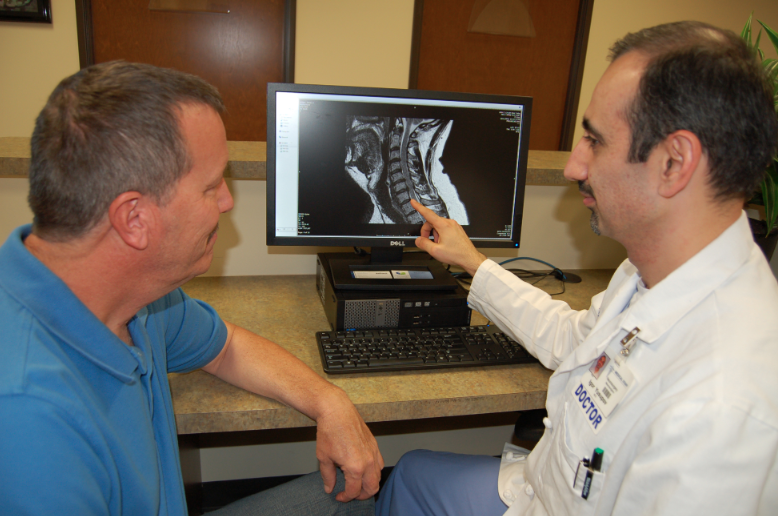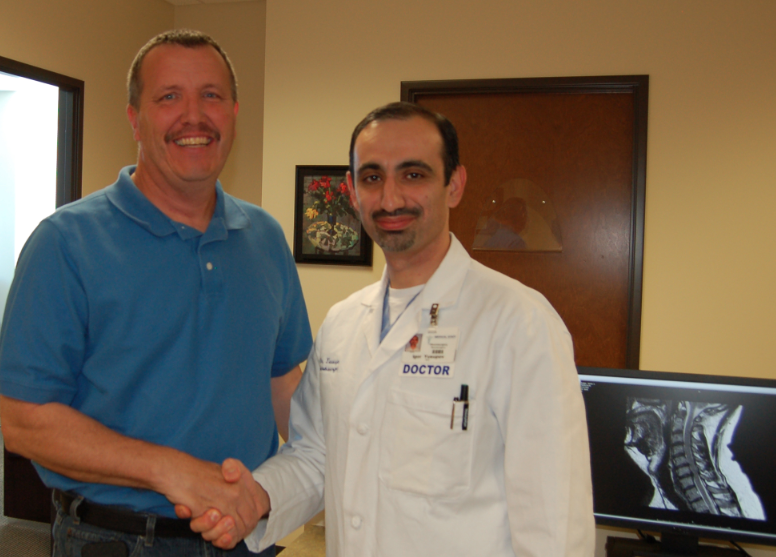Instant Paralysis to High-Stepping Celebration: Miracle Recovery Thanks to John C. Lincoln Neurologist, Neurosurgeon Teamwork.

It’s not every day that the Intensive Care nurses at John C. Lincoln North Mountain Hospital see one of their patients high-stepping around their unit, especially not the day after surgery. It’s no wonder they clapped and cheered.
The last time they saw such a performance? “It’s not something we usually see with patients in our unit,” ICU Clinical Director Robbi Johnson, RN, said. “It was really exciting to see such a quick recovery.”
Neurologist Eric Foltz, MD, and neurosurgeon Igor Yusupov, MD, were equally enthusiastic. Their patient’s mobility was a lot better than either of them expected.
“We were so happy,” Dr. Yusupov said. “The night after surgery, he was doing laps around the unit. That was amazing.”
The amazing patient is James Bolger, a 49-year-old construction worker with the City of Phoenix, who’s now doing well, doing physical therapy three times a week.
“I am very grateful for all the help I’ve had from the doctors, nurses and physical therapists who assisted in my care at both John C. Lincoln Hospitals,” he said. “It made a world of difference, and it made my family feel comfortable, because I was getting great care.
“And as a side note,” he added, “the food was great!”
But today’s joy is polar opposite of the morning Oct. 10, when Bolger woke up feeling very lightheaded and confused. “I had no warning,” he said. “I just had extremely poor balance when I woke up. I thought I was having a stroke.”

Bolger’s wife took him to the Emergency Department at John C. Lincoln Deer Valley Hospital, where they whisked him off to the MRI for a brain scan. Oddly, it showed clear tissue with no blood clots and no bleeding. No signs of stroke. Yet Bolger’s lightheadedness and balance problems were getting worse.
The ER admitted him to the hospital and called for an immediate neurological consult. Dr. Foltz responded, evaluated him and ordered another MRI, this one of his neck and upper spine. But because he’d already had one MRI with contrast that morning, they had to wait 24 hours to do the next one.
By the next morning things had continued to worsen. Still lightheaded, Bolger could no longer walk. “It wasn’t pain,” he said. “It was just that my legs would no longer obey my brain. I could move my legs while lying down, but when I tried to stand, my legs wouldn’t function.”
“You can imagine how scary that must have been,” Dr. Yusupov said. “If he’d had a desk job, and was suddenly facing life in a wheelchair because he’d lost function in his legs, it would be traumatic enough. But Jim is a man who physically works for a living. Without his full physical abilities, there’s a real question whether he could support his family.”
If there could be any good news in this sequence of events, Dr. Foltz said, it was that the problem came on suddenly. “The MRI showed compression in his spinal cord, caused by bulging discs. It’s not common that compression of the spinal cord and nerves in the neck and upper back cause leg problems. Usually compression in that area affects the arms. But everything is connected, so it’s not impossible.”
The important thing at that point, Dr. Foltz said, was to perform surgery as quickly as possible to relieve the pressure on the spinal cord before it caused permanent damage. He called Dr. Yusupov and had Bolger transferred to John C. Lincoln North Mountain Hospital.
Dr. Yusupov met Bolger and his wife, Gina, that night. “Dr. Foltz did an excellent diagnostic workup, great investigative work. It made my job easy,” Dr. Yusupov said.
“He assured us the problem was correctable,” Bolger said, “but he said time was of the essence, that we needed to have the surgery first thing in the morning.”
“The earlier the intervention, the better,” Dr. Yusupov said. “The problem was that compression was cutting off blood flow and oxygenation to the spinal cord. The cord wasn’t permanently damaged yet, but the longer we waited, the greater the risk that the damage would be permanent.”
It was all happening so fast. “We didn’t know what to do,” Bolger said, “but we liked the way Dr. Yusupov explained all of our options so we could make an informed decision and we trusted him. So we agreed to the surgery.”
Dr. Yusupov performed the very delicate surgery first thing the next morning, removing the bulging disc that was compressing Bolger’s spinal cord and replacing it with a prosthetic plug. He used plates and screws to stabilize Bolger’s spine.
As soon as Bolger woke up in ICU, he asked if he could get up and try to walk. Within two hours and with the help of a physical therapist, he was up on his feet and moving carefully with the use of a walker. By nightfall, he was up with his wife, the ICU nurse and his sister, doing laps around the nurses’ station.
And by the next morning, he was high-stepping to the sounds of the nursing staff’s applause and cheers.
